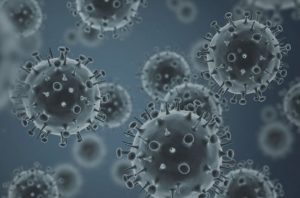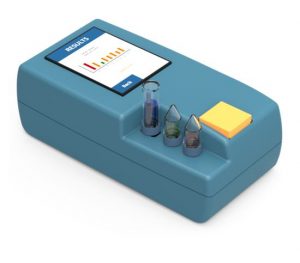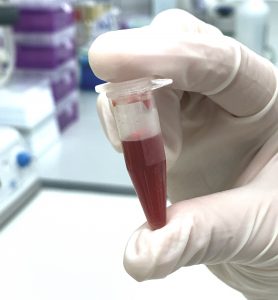31
| ICREA | Patents |
|---|---|
|
EXPERIMENTAL SCIENCES & MATHEMATICS |
|
| Julio Lloret Fillol (ICIQ) |
|
| ENGINEERING SCIENCES | |
| Turgut Durduran (ICFO) |
|
| Jose Antonio Garrido (ICN2) |
|
| Gerasimos Konstantatos (ICFO) |
|
| Arben Mekoçi (ICN2) |
|
| Aitor Mugarza (ICN2) |
|
| Valerio Pruneri (ICFO) |
|
| Romain Quidant (ICFO) |
|
| Neus Sabaté Vizcarra ((IMB – CNM) – CSIC)) |
|
| Samuel Sánchez Ordóñez (IBEC) |
|
| LIFE & MEDICAL SCIENCES | |
| Paul Christou (UdL) |
|
| Pablo Menéndez (IJC) |
|
| Antonio Postigo (IDIBAPS) |
|
| Aurora Pujol (IDIBELL) |
|
| Angel Raya (CRMB) |
|
| Ángel R. Nebreda (IRB Barcelona) |
|
| María Victoria Sánchez Vives (IDIBAPS) |
|
| Joan Seoane (VHIO) |
|
| Juan Valcárcel (CRG) |
|
| Miquel Vila Bover (VHIR) |
|
Science to Market
9
Eduard Batlle | CRC-MTOs - Colorectal Cancer Mouse Tumor Organoids as Pre-clinical Models for Therapeautical Testing
CRC-MTOs – Colorectal Cancer Mouse Tumor Organoids as Pre-clinical Models for Therapeautical Testing
Colorectal cancer (CRC) is one of the leading causes of death by cancer, which is closely connected to the spread of the disease in the body. Among the most promising therapeutic strategies to treat late stage cancers are immunotherapies. But only 5% of such advanced patients respond to immunotherapies. Progress to understand to what extent patients with metastatic CRC may benefit from immunotherapy has so far been limited by the lack of preclinical model systems to study late stage CRC under fully immunocompetent conditions.
This project aims to generate a unique pre-clinical model of advanced colorectal cancer (CRC) based on mouse tumour organoids (MTOs) to use for therapeutic testing of oncology products. Prof. Batlle’s newly generated MTOs will provide unique tools ready to be licenced and exploited in strategic public-private collaborations, with the ultimate goal to aid in the development of new drugs to treat advanced CRC sufferers. The research that his team, based at IRB Barcelona, will develop under the ERC’s PoC scheme will leverage the know-how he obtained during his previous ERC Advanced Grant: this involved the use of genome editing tools to modify organoids. This is Prof. Batlle’s second PoC grant, the first was to develop a test to predict the risk of CRC relapse.
Eduard Batlle – Institut de Recerca Biomèdica (IRB Barcelona)
ERC-PoC2018
Gerasimos Konstantatos | SPECTRODOT - Hand-held broadband hybrid graphene-quantum dots spectrometer
SPECTRODOT – Hand-held broadband hybrid graphene-quantum dots spectrometer
Optical Spectrometry is a powerful non-destructive, high throughput technique used extensively for threat and hazardous substance detection, food inspection, process and environmental monitoring and quality control amongst others. The market is fragmented into many niche markets, mainly due to the different wavelengths ranges of interest. Hybrid graphene-quantum dot photodetectors can enable versatile spectrometer covering the whole spectral range from UV to mid-IR. The main goal of SPECTRODOT is to develop a prototype low-cost, hand-held spectrometer with broadband range from 400 to 2500 nanometres.
Gerasimos Konstantatos – Institut de Ciències Fotòniques (ICFO)
ERC – PoC2018
Frank Koppens | GTRACK - Hybrid quantum dot and graphene wearable sensor for eye tracking
GTRACK – Hybrid quantum dot and graphene wearable sensor for eye tracking
The main goal of GTRACK is to demonstrate a semi-transparent eye-tracking system that is disposed in the line of sight of the user, for portable applications. To this end, we will use hybrid Quantum Dot – Graphene photodetectors. Eye-tracking existed since the 1800’s, but is expected to appear abundantly in our daily lives with the advent of virtual and augmented reality. In the existing systems, the camera has to be placed sufficiently close to the eye to capture enough IR light at sufficiently high resolution, while not blocking the user’s vision. By placing the camera directly on the lens, all these disadvantages are circumvented. Moreover, larger detectors can increase the sensitivity of the detectors and hence decrease the power consumption of the active illumination, which would allow for portable applications.
Frank Koppens – Institut de Ciències Fotòniques (ICFO)
ERC – PoC2017
Pablo Menéndez | IT4B-ALL - Therapeutic immunotherapy targeting NG2 and CD22 antigens for MLL-rearranged and MLL-germline B-cell Acute Lymphoblastic Leukemia
IT4B-ALL – Therapeutic immunotherapy targeting NG2 and CD22 antigens for MLL-rearranged and MLL-germline B-cell Acute Lymphoblastic Leukemia
B-ALL is the commonest cancer of childhood. There remain childhood B-ALL subgroups with dismal prognosis such as infant B-ALL and B-ALL carrying MLL rearrangements (MLLr). In addition, the prognosis of adult B-ALL is worse, and refractory/relapse (R/R) B-ALL remains dismal. CD19-targeted immunotherapies have emerged as promising therapeutic approaches for R/R B-ALL. CD19 CAR T-cells have shown impressive efficacy in R/R B-ALL. However, relatively rapid relapses are frequently observed, a proportion of them losing CD19 expression upon CAR19 T-cell therapy due to massive antigen pressure over CD19, resulting in a myeloid lineage switch in MLLr B-ALL, or the selection of CD19-/CD34+ preleukemic progenitors. Further CD19-targeted therapy is thus ineffectual for CD19neg R/R B-ALL. Our overarching goal is to provide novel therapeutic options for (R/R) B-ALL.Targeting surface antigens whose expression, opposite to CD19, are commonly retained at relapse is a valid strategy to circumvent the loss of CD19 found in (R/R) B-ALL after CD19-targeted therapies. Recent work funded by my ERC-2014-CoG has identified NG2 and CD22 as key antigens to be targeted in (R/R) B-ALL. First, both antigens are retained in CD19neg R/R B-ALL. Second, NG2 is solely expressed in MLLr B-ALL, and is associated with CNS infiltration, aggressiveness and glucocorticoid resistance. Third, CD22 is a pan-B marker expressed developmentally earlier than CD19, and CD34+CD22+CD19- cells may represent pre-malignant progenitors escaping the CD19-targeted pressure. These results have just been protected by a European Patent (EPI173825514), and are the proof-of-principle demonstration of NG2 & CD22 representing promising immunotherapeutic targets, when combined with CD19 for both MLLr & MLL-germline B-ALL, respectively. Here we propose to consolidate preclinical work and GMP production of anti-NG2 monoclonal antibody and NG2/CD19 and CD22/CD19 CAR T-cells to launch a PhaseI academic clinical trial for R/R B-ALL.
Pablo Menéndez – Institut Josep Carreras (IJC)
ERC – PoC2018
Ángel R. Nebreda | p38_InTh - Innovative therapeutic tools to ameliorate chemotherapy-induced cardiotoxicity
p38_InTh – Innovative therapeutic tools to ameliorate chemotherapy-induced cardiotoxicity
p38_InTh aims at improving the potency of a new class of highly specific p38 pathway inhibitors and validate their potential therapeutic use to ameliorate chemotherapy-induced cardiotoxicity without affecting the cancer cell toxicity of the chemotherapeutic. Chemotherapeutics used for cancer treatments have serious side effects, both the most broad-spectrum ones (such as anthracyclines) and the directed ones (such as trastuzumab). In particular, the cardiotoxicity is a major issue associated to chemotherapy. Cardiooncology research has recently emerged to tackle this serious unmet medical need. The cardiotoxicity induced by chemotherapeutics includes from arrhythmia to heart failure. To mitigate it, cardiooncologists usually adjust the treatment with reduced doses for a longer period, but this makes the anticancer treatments less efficient and consequently reduces the quality of life of the patients. There is evidence that cardiomyocyte death induced by anthracyclines involves activation of a specific p38 pathway, suggesting that inhibition of this pathway may reduce the cardiotoxicity associated with chemotherapeutics. Over the last two decades, many p38 pathway inhibitors have been developed by industry. However, these are mostly ATP competitors and have shown disappointing results in clinical trials. In contrast, we have recently identified novel compounds that inhibit only one of the target isoforms and through a novel MoA, selectively antagonizing the activation of this isoform by one of its protein partners. We propose to improve the potency of these hits and validate their potential therapeutic use to ameliorate chemotherapy-induced cardiotoxicity without affecting the cancer cell toxicity. Importantly, our new drug would inhibit only a subset of the p38 pathway regulated functions, which is expected to result in increased specificity, thereby overcoming the undesired side-effects found in clinical trials for the classical ATP competitive p38 pathway inhibitors.
Ángel R. Nebreda – Institut de Recerca Biomèdica (IRB Barcelona)
ERC – PoC2018
Samuel Sánchez Ordóñez | LABPATCH - Lab-in-a-patch for PKU self-assessment
LABPATCH – Lab-in-a-patch for PKU self-assessment
Phenilketonuria (PKU) is a congenital metabolic disease related to high levels of phenylalanine (Phe) in blood that, if not treated, can lead to intellectual disability, behavioural problems, and mental disorders. Life-long monitoring of Phe levels are necessary for PKU patients to avoid health (mainly neurological) issues. Currently available techniques for Phe assessment are costly, slow and take place only in clinical chemistry laboratories inside tertiary care hospitals, with a total analysis rate of one test every 1 month. Therefore, new technologies for frequent and rapid Phe analysis are required to improve PKU therapeutic efficacy, health monitoring and hence the quality of life of the patients. Here, we propose a fully integrated wearable patch for non-invasive self-assessment of PKU. The patch is designed to comfortably detect sweat Phe levels at home settings without medical expertise or expensive facilities. The patch contains electrodes modified with Phe-selective bioreceptors and is connected to a miniaturized controlling unit for electrode operation and wireless data transmission to external devices (smartphone, tablet, etc.). Overall, this project will provide, in an unprecedented manner, the fast monitoring of a rare disease with an integrated, compact, user friendly and non-invasive device. We aim at improving the way patients and doctors interact regarding the daily assessment of PKU. The produced devices will change how this rare disease is monitored, understood and will open new correlations between PKU and degree of health of patients. Furthermore, we expect that the concept of Lab-in-a-patch device proposed in this project will pave the way to the monitoring and assessment of other specific diseases.
Samuel Sánchez Ordóñez – Institut de Bioenginyeria de Catalunya (IBEC)
ERC – PoC2017
Luis Serrano | MycroVAP - Bacterial chassis for treating ventilator-asociated pneumonia (VAP)
MycroVAP – Bacterial chassis for treating ventilator-asociated pneumonia (VAP)
Among 65-80% of human infections are associated to biofilms, especially in respiratory infections or those associated with catheters. Endotracheal tube (ETT) biofilm is related to the development of ventilator-associated pneumonia (VAP), which occurs in 9–27% of all intubated patients. Those ETT-biofilms are mainly formed by Pseudomonas aeruginosa and/or Staphylococcus aureus, forming a protective barrier against antibiotics and the host immune system. The consequence of VAP is chronic inflammation resulting in slow but continuous decrease of lung function, which is the primary cause of mortality of patients at hospital wards, and is also associated with increased hospital morbidity; duration of hospitalization and consequently health care costs. Engineering bacteria to deliver locally therapeutic agents or to present antigens for vaccination is an emerging area of research with great clinical potential. Up to date, an attenuated BCG strain, used for prostate cancer vaccination, is the only example of a living bacteria used for human therapy. However, there are several studies worldwide at preclinical stage addressing the use of engineered bacteria for human therapy. We suggest here to test a non-pathogenic chassis of the mild human lung pathogen Mycoplasma pneumoniae, engineered to dissolve biofilms of S. aureus and P. aeruginosa for the treatment of VAP. The specific objectives of this proposal are: First, to confirm the safety of our bacterial chassis in the lung of animal models (mice and pigs). Second, to test the capacity of our engineered chassis to eliminate bacterial biofilms formed in endotracheal tubes and in mice models of biofilm formation. Success in both objectives will open the way to test our chassis in pig models of VAP as a first step towards its application in humans.
Luis Serrano – Centre de Regulació Genòmica (CRG)
ERC – PoC2018
Laura Soucek | SYST-iMYC - Development of an effective and safe systemic Myc inhibitor for the treatment of multiple cancer types
SYST-iMYC – Development of an effective and safe systemic Myc inhibitor for the treatment of multiple cancer types
Current cancer therapies target redundant cellular functions often compensated for by cancer cells, resulting in resistance to treatment. Here we propose an innovative approach to inhibit Myc, a non-redundant and “most-wanted” therapeutic target for human cancer. Targeting Myc has long been considered unfeasible because of the potentially catastrophic side effects in normal tissues. Against this dogma, we showed that Myc inhibition by Omomyc, a Myc mutant designed by Dr. Soucek, has a dramatic therapeutic impact in multiple mouse models of cancer, while causing only limited and reversible side effects. Critically, there is no emergence of resistance. Thanks to the ERC-2013-CoG n° 617473, we discovered the unexpected cell-penetrating properties of the purified Omomyc polypeptide. Moreover, we found that it is anti-tumorigenic after local (intranasal) delivery to mouse models of lung and brain tumors, and could therefore become the first clinically-viable direct Myc inhibitor. With this ERC PoC, we propose to develop a new drug based on an Omomyc variant that enables systemic treatment of several cancer types including lymphoma, breast, and melanoma. In all these cancers Myc contributes to multiple aspects of tumorigenesis including immune suppression. At the end of this project we will have a patent protected therapeutic polypeptide active in vitro and in vivo and ready to enter clinical trials Phase I/II in patients and to continue its commercialization. The forecasted peak revenue for such first-in-class drug in those indications reaches 2.612 M€ annually. With this ERC PoC project we will achieve essential milestones to develop this innovative therapeutic polypeptide by establishing the feasibility, including a commercial data package and cost estimations for the industrial production. Passing these milestones will de-risk the product and increase its value and probability of reaching the market by making it ready to be transferred to a spin-off company.
Laura Soucek – Vall d’Hebrón Institut d’Oncologia (VHIO)
ERC – PoC2018
Juan Valcárcel | VALSL - Valorisation of splice-switching oligonucleotides for lung cancer therapy
VALSL – Valorisation of splice-switching oligonucleotides for lung cancer therapy
Here we propose to test the therapeutic potential of a novel class of reagents, known as splicing-modifying antisense oligonucleotides, in preclinical models of lung adenocarcinoma, including patient-derived tumours in mice. Alternative splicing is a major mechanism of gene regulation by which different messenger RNAs and proteins are generated from a single gene, often displaying distinct, even antagonistic functions. Alterations in alternative splicing have been linked with a plethora of pathologies ranging from neurodegenerative disease to cancer. As a result of detailed mechanistic analyses of alternative splicing regulation in the context of the ERC-funded MASCP project, we have identified antisense oligonucleotides that modulate alternative splicing of a gene that plays key roles in the control of lung cancer cell proliferation. These reagents repress cell growth in vitro as well as inhibit tumour growth when administered intranasally in mouse models of lung adenocarcinoma. The main experimental goal of the ERC PoC proposal is to test the therapeutic value of the antisense oligonucleotides in a variety of patient-derived xenografts in mice, alone or in combination with other treatments, including chemotherapy. This will require previous optimization of dose and delivery route, which is being carried out with available support from other healthcare innovation funds. These goals are aligned with requests from various stakeholders, and funding from the ERC PoC program will be critical for successful valorisation of our assets, intellectual property protection and recruitment of venture capital to establish a spin-off company. Given the high incidence, poor prognosis and lack of efficient therapies for lung cancer, the work proposed can translate fundamental knowledge on molecular mechanisms of gene regulation derived from the ERC-funded MASCP project into applications whose valorisation can bridge the gap to market and provide added value for society.
Juan Valcárcel – Centre de Regulació Genòmica (CRG)
ERC – PoC2017
Spin-off companies
1
Droplite Technologies SL
Supported by the Institut de Ciències Fotòniques (ICFO) and ICREA
Entrepreneur: ICREA Research Professor Romain Quidant
Born in December 2018

DROPLITE is developing a medical diagnostics device that allows a rapid and accurate way to detect diseases and other health conditions in both humans and animals. We introduce an on-site quantitative automated test based on immunoassay techniques that runs in less than 10min utilizing one single drop of whole blood (or others such as saliva or urine). We believe our technology can compete and eventually replace the expensive and time-consuming ELISA laboratory tests currently in used in hospitals and clinics.
DROPLITE´s bio-sensing device is based on a reader + cartridge concept. A drop of blood of the patient is placed on an entry port of a small chip-cartridge, which is then introduced in a portable platform reader performing the detection and quantifying the concentration of the pathogen/molecule of interest present in the sample. The device, fully developed in house, is a combination of advanced microfluidics, customized chemistry, a proprietary optical detection system, electronics and signal processing.


We are currently exploring applications in several different markets such as:
(i) veterinary, regarding rapid detection of animal diseases,
(ii) quantitative analysis of allergies,
(iii) food safety,
(iv) hormone monitoring and
(v) early detection of infectious diseases.
